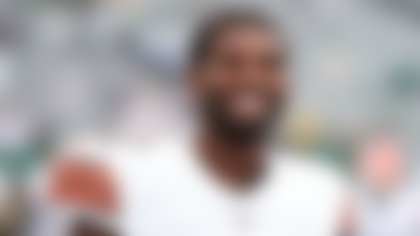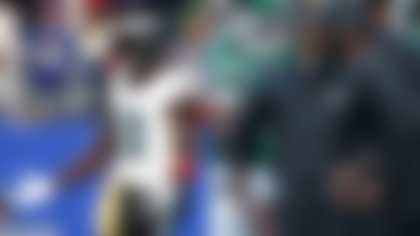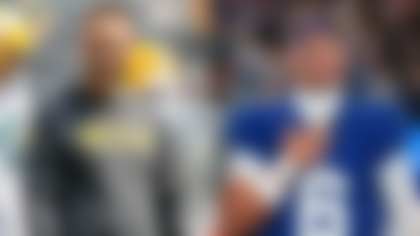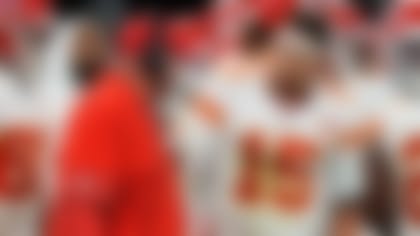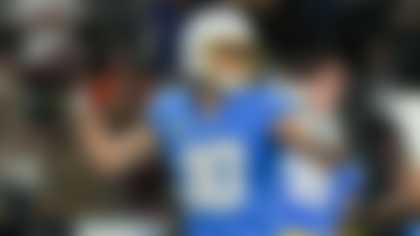Former NFL player and scout Bucky Brooks knows the ins and outs of this league, providing keen insight in his weekly notebook. The topics of this edition include:
But first, an examination of one young player who suddenly is taking the league by storm ...
* * * **
Whenever a running back walks past the velvet ropes to join the likes of Earl Campbell, O.J. Simpson and Ricky Williams in an exclusive club in the NFL record books, the football world takes notice. That's why scouts and evaluators are revisiting their notes from the 2015 NFL Draft to see if they missed on Miami Dolphins running back Jay Ajayi. The second-year pro just joined the aforementioned trio as the only running backs in NFL history to post back-to-back 200-yard rushing games.
I'll admit to being a little late to party on Ajayi during the pre-draft process, as I didn't include him among my top five RB prospects in the month before the 2015 NFL Scouting Combine, despite pointing out that he was a star on the rise near the end of his final season at Boise State.
Looking back at my pre-draft notes, I viewed Ajayi as a punishing downhill runner with an exceptional combination of size, strength and explosiveness. He attacked seams between the tackles with zest, exhibiting outstanding strength and power running through contact in the hole. Most impressively, Ajayi ran with an angry attitude that prompted him to seek out contact at the end of runs. With the big-bodied runner also displaying strong hands and solid ball skills, Ajayi looked like a natural three-down running back, albeit with a straight-line running style ideally suited to a zone-based scheme.
"He was a straight-line runner with size and speed," said an NFC scout who scouted Ajayi at Boise State. "I didn't expect him to light up the league like this, but he did have feet and hips. ... I thought he would be a one-cut slasher with the potential to be a solid starter."
That scout wasn't alone in his assessment of Ajayi as a potential RB1 at the next level. Several evaluators I spoke to recently also had viewed the Boise State standout as promising back during the pre-draft process.
"He's a good runner," an NFC senior personnel executive told me. "He had all of the tools, but he was always hurt or banged-up. If he could stay healthy, I thought he had a chance to be a prototypical feature back."
Despite earning high marks from several teams around the NFL, Ajayi wasn't selected until the fifth round. Part of his plummet could be attributed to durability concerns, but it is hard to find 6-foot, 229-pound runners with his kind of explosiveness (4.57 40 speed and 39-inch vertical) and burst.
That's why it was such a surprise to see Ajayi fail to make a significant impact as a rookie. He didn't log a single start during his first season and finished the year with only 187 rushing yards on 49 rushing attempts (3.8 yard per carry) over nine games.
This past offseason, though, Adam Gase spoke positively about Ajayi's potential as a feature back. Still, Ajayi hadn't learned how to work like a pro and failed to clearly earn a role as a starter thanks to inconsistency throughout training camp. After a disappointing performance during the Dolphins' final preseason game, Ajayi was a healthy scratch for the Dolphins' season opener against Seattle.
After earning his way back onto the field and playing as part of a rotation for the next four games, Ajayi finally was given an opportunity to carry the load against Pittsburgh in Week 6 and he responded in splendid fashion. He ran wild on the Steelers in a 25-carry, 204-yard effort with a pair of touchdowns. He followed it up a week later with a 28-carry, 214-yard performance (with another score) against the Bills.
While most observers have focused on Ajayi's spectacular production, I came away impressed with how well the Dolphins are meshing their scheme with their young runner's talents. As a straight-line runner adept at hitting creases between the tackles, Ajayi is at his best when attacking holes from the "dot" position (7 to 8 yards deep, directly behind the quarterback). According to the Next Gen Stats, 38 of Ajayi's 48 rushing attempts from a single-back formation have come with Ryan Tannehill positioned under the center. The rugged runner has averaged 7.8 yards per attempt on those runs, a figure that's unheard of in the NFL.
Part of Ajayi's success from single-back formations can be attributed to the alignment providing him with the opportunity to hit the hole with his shoulders square to the line. As a natural downhill runner, he is able to attack defenders with maximum power and explosiveness upon contact. Given his size and aforementioned strength, Ajayi is able to run through tackles and consistently finish his runs falling forward.
This is an important aspect of his game because it allows him to thrive versus loaded boxes. Against eight-man fronts in each of the past two games, Ajayi has gutted opponents between the tackles despite the presence of an extra defender. According to the Next Gen Stats, in his last two outings, he averaged 11.9 (eight rushes for 91 yards against Pittsburgh) and 8.6 (10 rushes for 86 yards against Buffalo) yards per carry against eight-man fronts. This is significant production for a runner against any front, much less one specifically designed to slow down the ground game. On the year, Ajayi is at 8.6 yards per carry against eight-man fronts -- more than two times the league average (3.4).
Long story short, Gase has found an effective counter to the run-stopping tactics defensive coordinators have thrown at Miami's newfound running game. Most importantly, the new head coach has helped the Dolphins establish an offensive identity that could carry them into the postseason.
ASK THE LEAGUE: Does Cam Newton have a point?
Cam Newton took matters into his own hands after last Sunday's game when he voiced his displeasure over the hits he's been taking -- hits he believes should be penalized. He said he "doesn't feel safe" in the pocket, with defenders taking shots at him from all angles. Newton suggested that he was going to reach out to Commissioner Roger Goodell to discuss the matter -- and he followed through on that promise, as the two chatted earlier this week. Given this story's prevalence throughout the week, I reached out to some knowledgeable folks to get their takes on the situation. Here's what I asked:
Do you feel like Cam Newton is being unfairly targeted by defenders?
NFC scout: "Yes. He's definitely getting 'extra' treatment from defenders. ... He kind of brought it on himself with the way he pranced around last season and stuff. The arrogance and dancing created a love/hate relationship and defenders are enjoying a little 'get back' right now. On the field, you can't really blame them for taking their shots at him because he puts you in such a bind when he's running the ball. If you play it soft, he will run you over -- so you have to take your shots when you get a chance."
NFC pro personnel director: "No! I think he's 6-foot-5, 248 pounds with 4.58 speed who is unbelievably difficult to tackle. Teams are simply swarming to the ball and making sure they gang tackle to get Newton on the ground."
AFC assistant pro director: "Cam gets hit a lot, but I don't think guys are targeting him, though. He simply doesn't get the calls that other quarterbacks get because he is so big. It's like 'the Shaq rules' in basketball. Big guys take a pounding from little guys because referees don't think the shots have a major impact. ... Remember, Cam has rare physical attributes for a quarterback. ... He will take two or three shots a year that are blatant because he stunts [showboats] on guys. He hot dogs a bit, so he puts his body at risk. Look at the Deion Jones hit."
Former NFL vice president of player personnel: "Absolutely. Defenders are smart. They are going to keep taking shots at him until the referees start calling it. ... I know he's a big man and 'running quarterback,' but he's getting pounded in the pocket and the refs aren't calling it. It's really embarrassing. ... I know they wouldn't be able to hit Tom Brady, Aaron Rodgers or Drew Brees like that without flags flying all over the place."
MY TAKE
It's uncommon to see an MVP quarterback take the kind of hits that Newton's absorbing in the pocket. The rules are designed to protect the quarterback, and elite signal callers are essentially viewed as "fine china" by the NFL. Any defender who treats them roughly typically receives a 15-yard penalty (and a hefty fine). That's the way officials have treated quarterbacks since the NFL shifted to a pass-happy league, so I'm miffed that Newton has taken an unmerciful beating in the pocket over the past two seasons.
Before you tweet at me about Newton's prowess as a runner, the reigning MVP is taking the bulk of his shots inside of the pocket. He has been head-slapped and smacked in the face with flailing arms attempting to swipe at the ball. Newton also has taken crushing shots under his chin by defenders taking an extra step or two before delivering the blow. Now, I know NFL officials will cite a number of stats suggesting Newton has received fair treatment, but I've also watched other quarterbacks with lesser résumés draw flag after flag in the pocket.
Maybe Ron Rivera and the assistant pro director quoted above are right when they suggest Newton receives "Shaq" treatment due to his remarkable size and physical stature. For instance, Newton was nearly decapitated by Broncos LB Brandon Marshall in the season opener when he tossed a ball while on the move. The energetic linebacker appeared to launch into Newton with the crown of his helmet. Marshall's hit did not draw a penalty in the game, though he was fined the following week. Last week, Arizona Cardinals' DT Calais Campbellrolled into Newton's legs as he threw a pass. Again, the play was not flagged, but Campbell eventually was fined. Although the hit wasn't intentionally delivered below his knees, Campbell's reckless play is against the rules and officials need to make it a point of emphasis to protect Newton in the pocket.
All that said, I do think it's important to put some of the blame on Newton for his role in his own battery. He is a flashy player who enjoys showboating and dancing when he makes big plays. While I love his exuberance, I know that his on-field behavior annoys defenders. They delight in punishing him at every turn, especially when the hits turn him into a guy prone to whining for calls. If Newton doesn't want to feel the wrath of defenders on the field, maybe he should tone down his antics when he makes a big play. Then opponents might take it a bit easier on the QB, instead of drilling him at every single opportunity.
BLAKE BORTLES: What's wrong with the Jaguars' franchise quarterback?
That question has come up quite a bit this season around the NFL Media office, with the Jacksonville Jaguars stumbling out of the gate to a 2-5 record after being widely hailed as a sexy breakout team heading into the season. Although the preseason optimism was tempered by the questions surrounding a young defense breaking in a number of rookies and second-year players, the Jaguars' high-powered offense was expected to fuel a potential playoff run behind solid play from a talented quarterback with the tools to perform at an elite level.
Not that I regarded Bortles as a "truck" in the quarterback landscape (a QB capable of carrying a team to the winner's circle with limited assistance), but I believed the Jaguars surrounded him with enough talent to allow him to play a highly functional role in the offense. If the third-year pro could manage the game, avoid big mistakes and lean on the team's explosive playmakers on the perimeter, I thought the Jaguars could hit the 10-win mark on the strength of their offense alone.
Remember, this is a unit that features a pair of 1,000-yard receivers from last season (Allen Robinson and Allen Hurns) and an athletic tight end with a knack for putting the ball in the paint (Julius Thomas, who has 32 career touchdowns in just 54 games). Not to mention, Jacksonville has a pair of rugged runners (Chris Ivory and T.J. Yeldon) in the backfield with the capacity to churn out hard yards between the tackles.
Thus, Bortles entered the season with high expectations that he would take his game up a notch in Year 3. But guess what? Even the best-laid plans can go astray. And the Jaguars' offensive struggles are largely due to the quarterback's spotty performance.
Bortles, who possesses uninspiring marks in completion percentage (60.0), yards per attempt (6.6) and TD-to-INT ratio (12:9), has yet to finish a game this season with a passer rating above 100.0 -- after recording five such games in 2015. On the year, his QB rating sits at a lowly 80.3. He has consistently been inefficient and ineffective as a playmaker, but I'm most concerned about his slow starts.
In a league where most play callers script the first 15 plays to help the quarterback get into a groove, Bortles has struggled with his first-quarter production. Since entering the NFL in 2014, he has thrown just four first-quarter touchdowns in 37 career games. This lack of early scoring routinely puts the Jaguars behind the eight-ball and they are forced to chase points for the rest of the game. Although Bortles rings up nice numbers when operating in catch-up mode -- particularly late in games, having tossed 26 of his 58 career touchdown passes in the fourth quarter -- he is essentially a fantasy football "garbage man" compiling meaningless numbers against prevent defenses.
With that in mind, Gus Bradley elected to part ways with offensive coordinator Greg Olson (more on that below) to see if he could spark struggling offense with better play from his young QB1. Nathaniel Hackett will now carry the call sheet after serving as the team's quarterback coach since the beginning of the 2015 season. He certainly will lean on his prior experience as a play caller (Buffalo Bills, 2013-14; Syracuse 2011-12) to bring some fresh ideas to an offense that too often appears stagnant at the beginning of games. Considering Hackett's success at Syracuse running a no-huddle spread offense, I would expect to see the Jaguars play with more tempo under the new OC. In addition, I believe the Jaguars could simplify their passing concepts to feature more quicks, screens and isolation routes that allow Bortles to simply "catch, rock and fire" from the pocket.
Remember, Bortles directed a fast-paced spread offense at Central Florida -- and he has shown promise when playing in the no-huddle with Jacksonville. Bortles has posted impressive numbers when operating at a breakneck pace at the end of halves/games this season: He has a 70 percent completion rate, 4:2 TD-to-INT ratio and 104.4 passer rating in the last two minutes of a half in 2016. Thus, it would be a sensible choice to put him in a no-huddle offense that simplifies his reads and forces the defense into vanilla looks. (Defensive coordinators scale back blitzes and pre-snap disguises against no-huddle teams due to communication concerns.)
Despite the Jaguars' potential tactical changes, the pressure is on Bortles to fix his game and play like a franchise quarterback down the stretch. As the third overall pick in the 2014 draft, he is expected to be a difference maker and must fulfill that promise for the Jaguars to have any chance of turning around their season. Bortles needs to reduce his turnovers (52 career giveaways) and become a more accurate intermediate passer. He misses too many "gimme" throws and those incompletions disrupt the rhythm of the offense.
"Too many inconsistencies to his game," an AFC scout told me. "From his footwork issues to his lack of poise and pocket awareness, he has a lot to fix. ... I don't like his delivery -- he's too quick to scramble and he struggles with his accuracy. Plus, he forces throws into traffic."
After studying the All-22 Coaches Film from Bortles' most recent performances, it's hard to disagree with those critiques. He is not playing well from the pocket and his shoddy footwork/fundamentals have been an issue since he stepped into the league. In fact, I thought he would need some time to grow into a role as a franchise quarterback when I studied him prior to the draft.
While Bortles has grown in certain areas and flashed enough raw potential to still induce optimism about his long-term chances of success, the Jaguars need to see him show progress. And Bortles must deliver some wins soon, or Bradley will see someone else mentor the team's franchise quarterback in 2017.
COORDINATOR CHANGES: The impetus for this midseason madness
After watching four well-respected coordinators get dismissed by the midpoint of the season, I'm beginning to believe Jerry Glanville was definitely onto something when he famously quipped that the NFL means "Not For Long." The heightened expectations from owners, general managers, head coaches and fans have created a culture where NFL coordinators are treated like microwave chefs in today's game. If a play caller is unable to take the ingredients and quickly put together a masterpiece, he is tossed aside and replaced by another coach with a different recipe and formula.
Now, I know the league is one where production and performance matters, but the spate of midseason dismissals speaks volumes about the pressure coaches face in today's games. Teams are expected to vie for the title each and every season while racking up impressive fantasy football-like numbers and splashy highlights.
"There aren't any realistic expectations in sports," one former NFL general manager told me. "Everyone expects their team to be in the Super Bowl, Final Four or College Football Playoffs at the end of every season. If you aren't playing for the trophy, the season is viewed as a failure. ... There's something wrong with that, but that's the world we live in."
Although every coach in the league faces immense pressure to produce blockbuster results, offensive coordinators are catching it the worst because the league is governed by quarterbacks, and the "most important player" on each team must be put in the best position to succeed. Looking at each of the coordinator changes this season (Greg Roman in Buffalo; Marc Trestman in Baltimore; Greg Olson in Jacksonville; and Norv Turner, who resigned this week from his post in Minnesota), it's not a coincidence that their QB1s were struggling at the time of the divorce. Regardless of whether their struggles were due to faulty play calling or game planning, offensive coordinators are paying for the sins of their quarterbacks. Fair or not, the job description of the offensive leader is to make sure the quarterback thrives because most decision makers (owners, general managers and head coaches) believe the game must flow through the signal caller.
"Coordinators are judged on their ability to create plans that match the personnel," said the former general manager. "Are the top players being put into a position to exploit their talents? Are players being asked to do things that match their skills? Those are the questions decision makers ask when evaluating play callers. ... If the coordinator fails to maximize the individual and collective talents of personnel, then you have to think about making a change."
Despite the former executive citing the deployment of the team's top players, it ultimately comes back to setting up the quarterback for success. Teams surround the quarterback with skill players capable of alleviating pressure on the signal caller, whether it's an explosive deep-ball specialist to help a strong-armed passer or a catch-and-run playmaker to help a dink-and-dunk passer deliver explosive plays in a controlled passing game. Throw in a rugged workhorse runner to attract eight-man fronts or single-high coverage, too. The pro game is all about helping the quarterback play at his best.
With front offices expected to provide the players and coaches responsible for crafting the plan, the job falls on the offensive coordinators to take the pieces and put them in a system that allows them to play to their strengths while creating an adaptable plan that allows the quarterback to play "fast and free" in the pocket. Considering how many QBs enter the league after spending most of their high school and collegiate careers directing spread offenses, today's coordinators need to be familiar with the concepts that are being utilized at the game's lower levels to help the signal caller thrive. Instead of forcing quarterbacks to learn a complex offensive system that's long on verbiage and complicated reads, play callers must find a way to shrink their call sheets and help the quarterback find easy completions on the perimeter.
Whether it's through RPOs (run-pass options), bootleg and movement passes, or vertical throws and quick-rhythm passing plays from shotgun formation or under center, the job of the coordinator is to know what makes his quarterback tick and to find a way to put him in his comfort zone. That's why I'm paying close attention to Nathaniel Hackett's work in Jacksonville and Pat Shurmur's work in Minnesota to see how they blend in their ideas with the established schemes that are currently in place. Shurmur, in particular, is squarely in my crosshairs as he takes over a Vikings offense that is being led by a quarterback he originally helped introduce to the NFL (Sam Bradford). With the veteran quarterback now viewed as the centerpiece of the offense after a spate of injuries robbed the team of a franchise running back (Adrian Peterson), it's sensible for the Vikes to rebuild their scheme around Bradford's skills.
"People forget that [Shurmur] was the guy that helped Bradford win the Offensive Rookie of the Year award," said a former vice president of player personnel. "This should be a great move for him because Shurmur knows exactly what he does best. In St. Louis, it was a short, controlled passing game with a few deep shots sprinkled in. ... I don't know if he can overhaul the offense in the middle of the season, but I would expect the scheme to better suit Bradford's talents."
Considering how some midseason coordinator moves have previously sparked unexpected Super Bowl runs (see Jim Caldwell taking over for Cam Cameron in Baltimore) or saved head coaching jobs, there are a few teams hoping new cooks can whip up different results in a hurry.
Follow Bucky Brooks on Twitter @BuckyBrooks.

